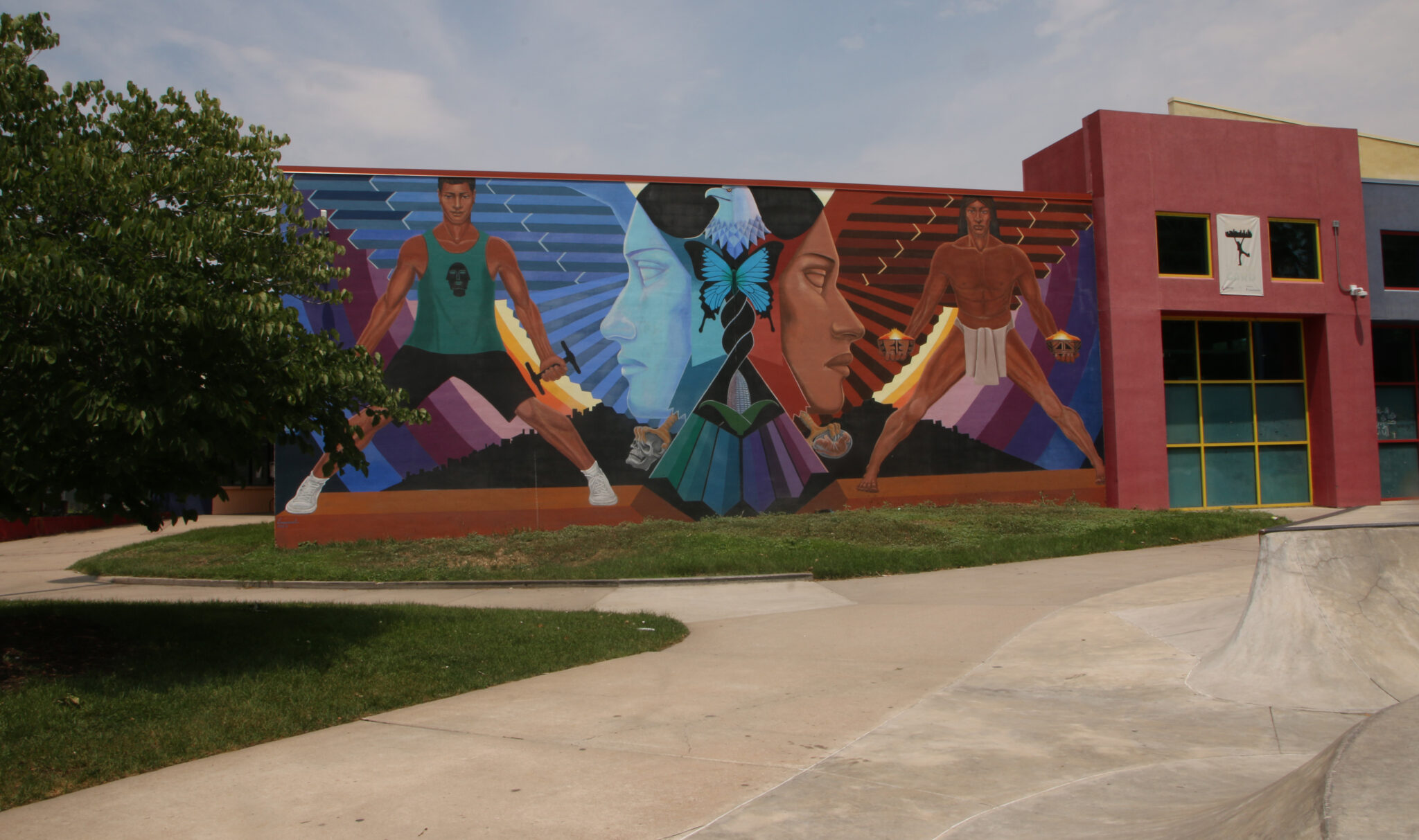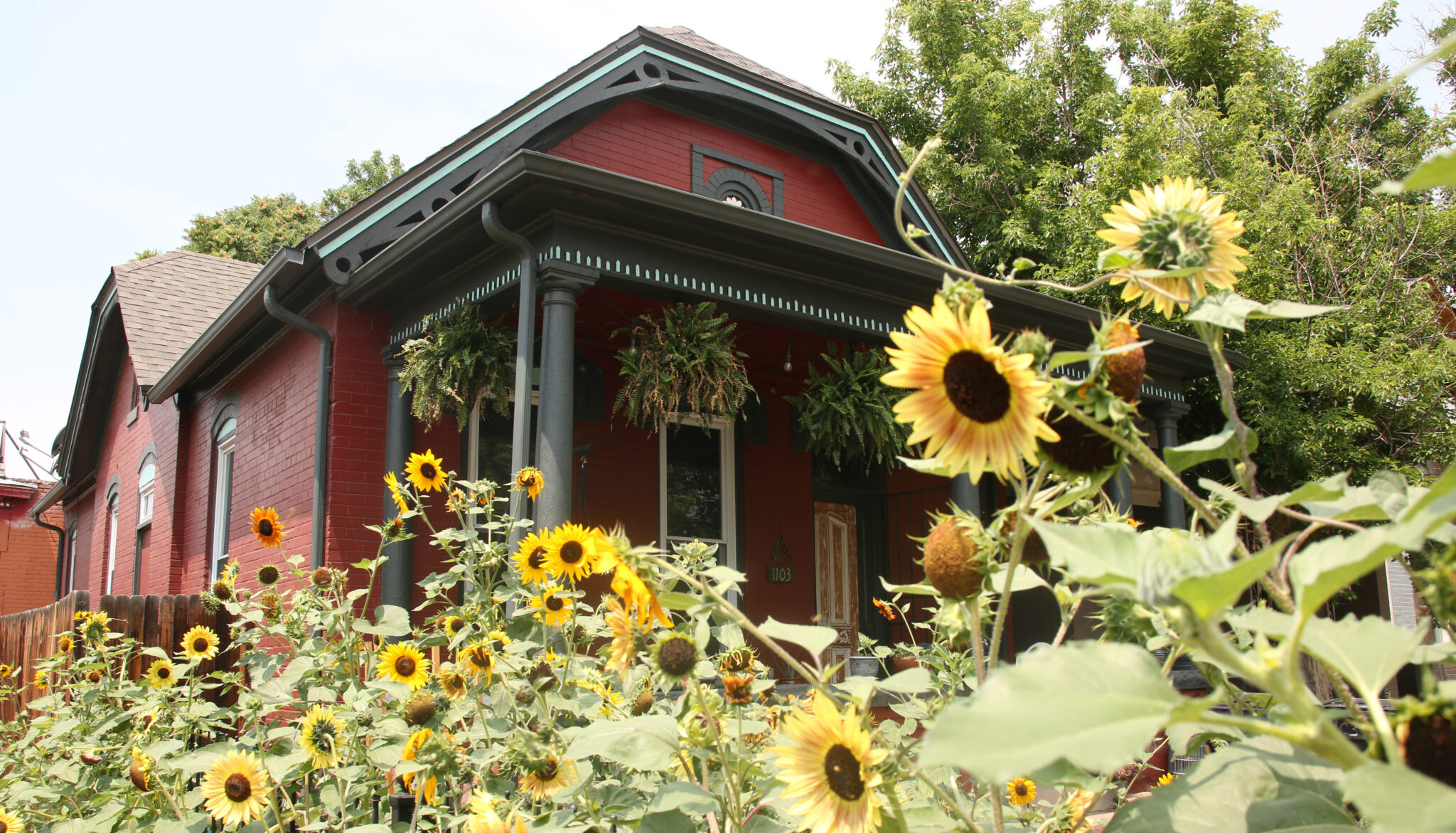
La Alma Recreation Center’s mural, painted by Emanuel Martinez in 1978, depicts the Chicano influence of the Lincoln Park neighborhood, where a historic district is close to being approved. (Eric Heinz photos)
Chicano architecture, a recreation center with a vibrant mural and many single-family homes in Lincoln Park are close to becoming Denver’s next historic district.
A Denver City Council committee on Tuesday unanimously voted to forward an application to establish the La Alma Lincoln Park historic district to be considered by the full council on Aug. 2.
It would be one of the first to be designated under the city’s “cultural” criteria, according to the applicants.
According to a statement from the La Alma-Lincoln Park Neighborhood Association, the area was at the center of the Chicano movement in Denver in the 1960s and 1970s. Since 2017, the association said it has hosted several walking tours of the area and community meetings.
Applicants said the area is also associated with historic prominence from the 1870s, when railroads were being built through Denver.
Not all of the Lincoln Park neighborhood would be included in the historic district if it is approved.
The boundaries of the proposed district are a portion of 14th Avenue to the north, bordered by a recreation center and La Alma-Lincoln Park to the west, portions of 10th Avenue to the south and generally Kalamath Street to the east.
The district would include mostly residences and some commercial properties and the La Alma Recreation Center.
The proposed borders of the historic district were designed by the applicants who used an application for the area to be listed on the National Register of Historic Places in the 1970s as a guideline, but residents of the area also gave their input, according to Annie Levinsky, executive director of Historic Denver, which was part of the application process.

A home at the corner of 11th Avenue and Lipan Street in the Lincoln Park neighborhood is part of a proposed historic district in the area. The Denver City Council is expected to vote on the designation Aug. 2.
Kara Hahn, a Denver city principal planner, said each historic district designated with cultural criteria will have a unique set of design review guidelines that will govern proposed significant changes to a structure. Those plans will be formalized in August or September, if the district is approved by the full council, she said.
“So, if you want to paint your house, go ahead and paint it whatever color you want, do what you want to do for general repair and maintenance,” Hahn said. “That’s not anything we would review. It’s only if (the actions) would require a building and zoning permit.”
Hahn said the design review plans for the La Alma Lincoln Park historic district would be “flexible” to allow owners to make improvements, and owners within the historic district would face lower costs associated with the permitting process.
If a building deemed by the city to be “contributing” to the district is severely damaged and needs significant repairs or demolition, the owner could apply for a demolition permit through the Landmark Preservation Commission, but Hahn said those are “fairly rarely approved.”
“If you just touch the brick and it’s falling apart … and then to repair and replace it would be worth more than the value of the house, (an owner) can appeal to the commission for an economic hardship,” Hahn said.
Property owners within historic districts in Denver can apply for state historic preservation income tax credits for preservation and rehabilitation work, according to the city’s website.
Residential and commercial property owners within a historic district can receive a credit of 20 percent of their qualified rehabilitation costs, up to $50,000.
Structures that are deemed by the city as “non-contributing” — those that have been built within the last 40 years or have had major alterations — do not qualify for the credits, nor are they subjected to the district’s design review standards.
Surveys by Historic Denver and public comments from prior meetings on the district showed a majority of residents were in favor of the historic-cultural designation.

La Alma Recreation Center’s mural, painted by Emanuel Martinez in 1978, depicts the Chicano influence of the Lincoln Park neighborhood, where a historic district is close to being approved. (Eric Heinz photos)
Chicano architecture, a recreation center with a vibrant mural and many single-family homes in Lincoln Park are close to becoming Denver’s next historic district.
A Denver City Council committee on Tuesday unanimously voted to forward an application to establish the La Alma Lincoln Park historic district to be considered by the full council on Aug. 2.
It would be one of the first to be designated under the city’s “cultural” criteria, according to the applicants.
According to a statement from the La Alma-Lincoln Park Neighborhood Association, the area was at the center of the Chicano movement in Denver in the 1960s and 1970s. Since 2017, the association said it has hosted several walking tours of the area and community meetings.
Applicants said the area is also associated with historic prominence from the 1870s, when railroads were being built through Denver.
Not all of the Lincoln Park neighborhood would be included in the historic district if it is approved.
The boundaries of the proposed district are a portion of 14th Avenue to the north, bordered by a recreation center and La Alma-Lincoln Park to the west, portions of 10th Avenue to the south and generally Kalamath Street to the east.
The district would include mostly residences and some commercial properties and the La Alma Recreation Center.
The proposed borders of the historic district were designed by the applicants who used an application for the area to be listed on the National Register of Historic Places in the 1970s as a guideline, but residents of the area also gave their input, according to Annie Levinsky, executive director of Historic Denver, which was part of the application process.

A home at the corner of 11th Avenue and Lipan Street in the Lincoln Park neighborhood is part of a proposed historic district in the area. The Denver City Council is expected to vote on the designation Aug. 2.
Kara Hahn, a Denver city principal planner, said each historic district designated with cultural criteria will have a unique set of design review guidelines that will govern proposed significant changes to a structure. Those plans will be formalized in August or September, if the district is approved by the full council, she said.
“So, if you want to paint your house, go ahead and paint it whatever color you want, do what you want to do for general repair and maintenance,” Hahn said. “That’s not anything we would review. It’s only if (the actions) would require a building and zoning permit.”
Hahn said the design review plans for the La Alma Lincoln Park historic district would be “flexible” to allow owners to make improvements, and owners within the historic district would face lower costs associated with the permitting process.
If a building deemed by the city to be “contributing” to the district is severely damaged and needs significant repairs or demolition, the owner could apply for a demolition permit through the Landmark Preservation Commission, but Hahn said those are “fairly rarely approved.”
“If you just touch the brick and it’s falling apart … and then to repair and replace it would be worth more than the value of the house, (an owner) can appeal to the commission for an economic hardship,” Hahn said.
Property owners within historic districts in Denver can apply for state historic preservation income tax credits for preservation and rehabilitation work, according to the city’s website.
Residential and commercial property owners within a historic district can receive a credit of 20 percent of their qualified rehabilitation costs, up to $50,000.
Structures that are deemed by the city as “non-contributing” — those that have been built within the last 40 years or have had major alterations — do not qualify for the credits, nor are they subjected to the district’s design review standards.
Surveys by Historic Denver and public comments from prior meetings on the district showed a majority of residents were in favor of the historic-cultural designation.

Leave a Reply